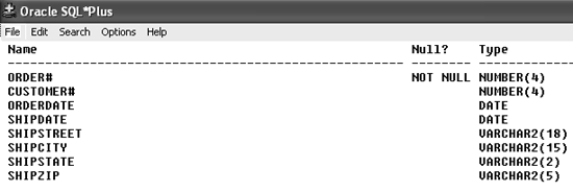A) SELECT title
FROM customers NATURAL JOIN orders
NATURAL JOIN orderitems NATURAL JOIN books
WHERE orderdate - pubdate >= 3;
B) SELECT title,
FROM orders o, orderitems oi, books b
WHERE
C) isbn = oi.isbn AND oi.order# = o.order# AND (orderdate-pubdate) /365 >= 3;.
D) isbn = oi.isbn AND oi.order# = o.order# AND orderdate - pubdate >= 3;,
E) SELECT title.
FROM orders o, orderitems oi, books b
WHERE..
G) A) and B)
Correct Answer

verified
Correct Answer
verified
Multiple Choice
Which of the following terms refers to a column with equivalent data that exists in two or more tables?
A) common column
B) equiv-column
C) inner columns
D) simple columns
F) None of the above
Correct Answer

verified
Correct Answer
verified
True/False
When a self-join is created, each copy of the table must be assigned a table alias.
B) False
Correct Answer

verified
Correct Answer
verified
Multiple Choice
Which of the following keywords is used to create a Cartesian join?
A) OUTER JOIN
B) CROSS JOIN
C) NATURAL JOIN
D) JOIN...USING
F) C) and D)
Correct Answer

verified
Correct Answer
verified
True/False
A cross join between two tables, containing four rows each, will display rows in its output. _________________________
B) False
Correct Answer

verified
Correct Answer
verified
Short Answer
The ____________________ JOIN keyword can be used to create a Cartesian join.
Correct Answer

verified
Correct Answer
verified
Short Answer
The outer join operator can only be used in the ____________________ clause.
Correct Answer

verified
Correct Answer
verified
Multiple Choice
A join based upon a column from each table containing equivalent data is known as a(n) ____.
A) inequality join
B) outer join
C) equality join
D) all of the above
F) B) and C)
Correct Answer

verified
Correct Answer
verified
Short Answer
____________________ operators are used to combine the results of multiple queries.
Correct Answer

verified
Correct Answer
verified
Short Answer
A self-join can only be specified in the FROM clause with the use of the JOIN...____________________ keywords.
Correct Answer

verified
Correct Answer
verified
True/False
An outer join operator can be included in a FROM clause to list all rows from one table that do not have a corresponding row in the other table.
B) False
Correct Answer

verified
Correct Answer
verified
True/False
The UNION set operator will not suppress rows that are returned by both queries.
B) False
Correct Answer

verified
Correct Answer
verified
Multiple Choice
 Structure of the ORDERS table
Structure of the ORDERS table
 Structure of the CUSTOMERS table
-Which of the following SQL statements will list the name of each customer stored in the CUSTOMERS table, and, if the customer has placed an order that is contained in the ORDERS table, the order# of any order each customer has placed?
Structure of the CUSTOMERS table
-Which of the following SQL statements will list the name of each customer stored in the CUSTOMERS table, and, if the customer has placed an order that is contained in the ORDERS table, the order# of any order each customer has placed?
A) SELECT lastname, firstname, order#
FROM customers NATURAL JOIN orders;
B) SELECT lastname, firstname, order#
FROM customers c LEFT OUTER JOIN orders o
ON
C) SELECT lastname, firstname, order#
FROM customers RIGHT OUTER JOIN orders;
D) customer# = o.customer#;
E) SELECT lastname, firstname, order#
FROM customers JOIN orders USING (customer#) ;
G) All of the above
Correct Answer

verified
Correct Answer
verified
Short Answer
A table alias can have a maximum of ____________________ characters.
Correct Answer

verified
Correct Answer
verified
True/False
If you are joining four tables in a SELECT statement, joining conditions will be required. _________________________
B) False
Correct Answer

verified
Correct Answer
verified
Short Answer
When two tables that share more than one common column are being joined, the JOIN...____________________ keywords are normally used in the FROM clause to join the tables.
Correct Answer

verified
Correct Answer
verified
Multiple Choice
Which of the following is an example of assigning "o" as a table alias for the ORDERS table in the FROM clause?
A) FROM o orders, c customers
B) FROM o.orders,
C) FROM orders o, customers c
D) customers
E) FROM orders.o, customers.c
G) C) and D)
Correct Answer

verified
Correct Answer
verified
True/False
The MINUS set operator is used to display rows that were uniquely returned by the first query in the set.
B) False
Correct Answer

verified
Correct Answer
verified
True/False
The JOIN keyword must be used in the clause of a SELECT statement. _________________________
B) False
Correct Answer

verified
Correct Answer
verified
True/False
The clause can be used only if the tables being joined have a common column with the same name. _________________________
B) False
Correct Answer

verified
Correct Answer
verified
Showing 61 - 80 of 131
Related Exams